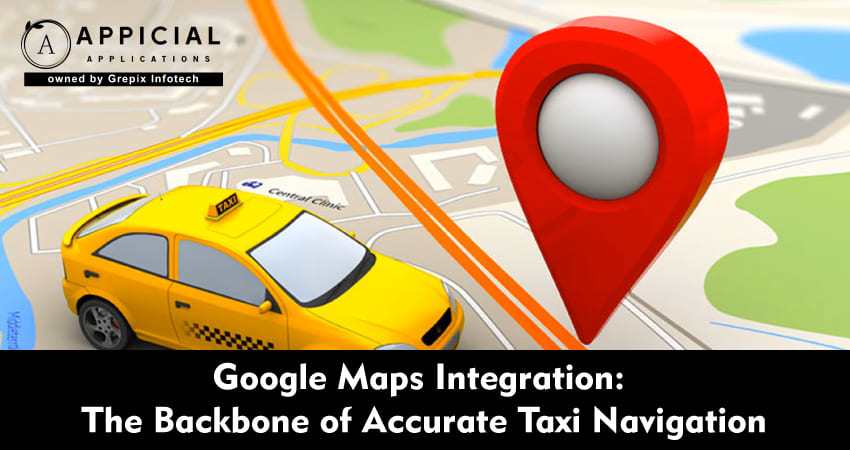
Google Maps Integration: The Backbone of Accurate Taxi Navigation
Precision in mapping, real-time traffic awareness, turn-by-turn routing, and reliable ETA estimation have grown from “nice features” to mandatory infrastructure for any serious ride-hailing app or ride-sharing app. Without a robust navigation backbone, your platform invites misroutes, delays, poor driver utilization, cancellation risk, and a damaged reputation.
Integration with Google Maps has become the de facto standard for modern Uber Clone and e-hailing app platforms. The question is not whether to integrate maps, but how well to embed Google Maps to power all navigation, dispatch, tracking, and route logic. Below, we examine the rationale, architecture, challenges, and best practices of Google Maps integration and provide direction for building a resilient, scalable navigation core through a capable taxi app development company or white label taxi app development company.
In this blog, we explore why integrating Google Maps is essential to deliver accurate navigation, ETA estimation, and route optimization in modern ride hailing apps, ride sharing apps, and e-hailing apps. We dissect the technical and operational benefits, key APIs, best practices, challenges, and roadmap for integration. We also show how a dedicated taxi app development company or white label taxi app development company can implement robust Google Maps capabilities in an Uber Clone or white label taxi booking app. The conclusion highlights Appicial Applications as the ideal partner to build a navigation-strong ride hailing solution, with a clear CTA.
Why Google Maps Matters for Taxi Navigation?
Superior Coverage, Accuracy, and Real-Time Traffic Data
Google Maps boasts over 2.2 billion active users globally as of 2025, and its real-time traffic predictions reach ~94 % accuracy according to recent surveys. The map coverage is global and continuously updated. For a ride hailing app, this ensures that no matter where you deploy your white label taxi booking app, you benefit from comprehensive road network maps, traffic data, and route alternatives.
Studies and industry implementations show that when ride hailing services embed Google Maps deeply, they can improve ETA accuracy by up to 48 % and reduce overall ride durations by ~4 %. This kind of improvement matters directly to customer satisfaction, driver earnings, and platform efficiency.
Native Integration vs External Navigation Apps
In early ride sharing systems, drivers often switched between the app and external navigation (Google Maps or Waze). That context-switching leads to user confusion, loss of session, and mismatches in routing context. With embedded Google Maps integration, the navigation is native, eliminating context loss, improving accuracy in route guidance, and keeping the driver within the app environment. This embedding is a hallmark of advanced Uber Clone or e-hailing app solutions.
Address Validation, Geocoding, and Place Autocomplete
A taxi app needs solid geocoding (address → lat/long) and reverse geocoding (lat/long → address) capabilities. Google Maps (via Places API, Geocoding API) offers high-quality address suggestions, validation, and auto-completion of user input. That reduces input errors, missed pickups, and user frustration. A ride sharing app with Google Maps autocomplete is less prone to invalid addresses.
Predictable Scalability and Support
Google Maps APIs have mature infrastructure, developer support, SLAs, and regional data. A taxi app development company or white label taxi app development company can rely on Google’s scaling, versioning, and updates rather than maintaining map data manually or building custom map layers. This stability is essential when your white label taxi booking app scales across cities or countries.
Unified Analytics, Route Metrics & Business Intelligence
Google Maps integration doesn’t just help navigation; it aids analytics. With integrated mapping, you can capture detailed route telemetry (route distance, deviations, traffic slowdowns). This data feeds into your business intelligence, driver performance tracking, dynamic pricing, and dispatch optimization. For a ride hailing app or Uber Clone, that integration is the backbone of monitoring operational KPIs.
What Google Maps APIs & SDKs Are Essential for Taxi Navigation?
Maps SDK / Map Display
This is the foundational component: embedding map tiles, markers, polylines, and overlays. The Uber Clone or ride sharing app UI uses Maps SDK to show driver location, route, pickup and drop-off pins, and live movement.
Directions API / Routes API
To compute the optimal path from pickup to drop-off, the Directions API or Routes APIs are central. They consider road geometry, traffic, restrictions, and dynamic recalculation. Your ride hailing app must use this to generate the route and guide the driver.
Traffic and Real-Time Data Layers
Google Maps provides live traffic layer overlays. The integrated platform can pull traffic delays, road speed data, incidents, and suggest alternate paths. This dynamic re-routing capability is crucial for a modern e-hailing app.
Places API / Autocomplete / Place Search
For destination input, autocomplete capability is essential. This reduces user typing errors, speeds up the booking flow, and ensures that addresses map to valid road points. The white label taxi booking app should embed Places API to support this.
Geocoding & Reverse Geocoding
When user enters an address, Geocoding API translates to lat/lng; when driver’s location is recorded, reverse geocoding gives human-readable addresses. A ride sharing app needs accurate geocoding for route summaries, fare calculations, and for showing pickup / drop-off labels.
Snap to Roads & Speed Limit APIs
Snap to roads ensures GPS traces get aligned with actual road geometry. Speed limit info aids in safer navigation and risk computation. These APIs help your taxi app development company build smoother route following and avoid off-road mapping artifacts.
Distance Matrix API
To compute multiple origin-destination pairs (e.g. driver → pickup, pickup → drop-off), Distance Matrix is useful. This enables efficient dispatch in a ride hailing app, helping match drivers based on realistic travel cost.
Elevation / Geometry APIs (optional)
In certain geographies with elevation changes or complex roads, these APIs assist in accurate visualization and route shaping. A high-quality Uber Clone may incorporate them for deeper mapping nuance.
How Google Maps Integration Impacts Core Ride Hailing Functions?
Enhanced ETA Estimation and Accuracy
When integrated properly, Google Maps enables precise predictions of arrival times. In real-world use, platforms saw up to 48 % improvement in ETA accuracy after switching to deep integration. That precision reduces passenger anxiety, reduces driver wait time, and lowers cancellation risk. A ride sharing app must leverage these gains to keep users satisfied.
Dynamic Re-Routing and Traffic Adaptation
Traffic conditions change rapidly. With real-time traffic layers from Google Maps, the driver route can be adjusted mid-route to avoid delays, reduce idling, or circumvent accidents. That adaptability enhances reliability in a ride hailing app. Without integrated re-routing, your Uber Clone may suffer major delays and unhappy passengers.
Efficient Dispatch and Matching
Because your dispatch logic can query real travel times and distances using Google Maps APIs, drivers can be matched more intelligently. A white label taxi booking app can prioritize drivers who will truly arrive sooner (not just closer in straight-line distance). The platform profitability and utilization improve.
Better Driver Guidance and Visual Navigation
A driver must see not only a route but turn-by-turn instructions, lane guidance, upcoming junctions, and alerts. With Google Maps integration, navigation is visually rich and context-aware. That reduces mis-turns, confusion, and near-misses. A taxi app development company designs the driver module around this.
Precise Pickup Handling
Many challenges in ride hailing are pickup mismatches, driver arrives at wrong entrance, alley, or building side. Google Maps’ place context, street view, and address validation can help normalize pickup points. A robust e-hailing app uses mapping to refine pickup logic and reduce driver-passenger friction.
Monitoring Deviations and Route Compliance
Google Maps integration allows the system to monitor if the driver deviates significantly from the suggested route (e.g. detours, shortcuts). The platform can trigger alerts, recalculate paths, or notify riders. This is important for trust and safety in a ride sharing app.
Analytics for Optimization
Route and telemetry data from Google Maps feed into analytics modules. You can analyze average route deviation, typical time lost due to traffic, zones of congestion, and optimize driver incentives or surge zones. A taxi app development company integrates these pipelines.
What Challenges to Expect And How to Overcome Them?
API Costs and Quota Management
Google Maps APIs (directions, distance matrix, autocomplete) are usage-based. Heavy demand (many drivers, pickups, re-routes) can inflate cost. You need to design caching, reduce redundant calls, and manage quotas. A rigorous white label taxi app development company will architect smart caching, fallbacks, and throttle strategies.
Latency and Real-Time Performance
Navigation must respond fast. Any latency in route generation or traffic update can frustrate users or cause wrong turns. You need efficient asynchronous calls, local caching of map tiles, and fallback logic. The taxi app development company must stress-test in real conditions and optimize.
Offline or Poor Connectivity Modes
In zones with weak mobile network, your navigation may fail. You might incorporate offline caching or fallback to minimal routing logic. But full Google Maps capabilities require connectivity. Planning fallback flows is essential for a ride hailing app to remain usable in coverage gaps.
Edge Cases, Map Inaccuracies, and Local Roads
In some territories, Google Maps coverage might lag or local roads may be missing or outdated. In such geographies, the Uber Clone may need hybrid mapping (local map augment + Google Maps). You should plan for local map correction pipelines or partner map sources.
Versioning, SDK Updates, and Deprecation
Google periodically changes APIs, SDKs, and pricing. A maintenance plan is necessary to migrate and adjust. A ride sharing app built by a mature taxi app development company will have upgrade paths and modular mapping abstraction to adapt to API changes.
Security and Key Management
Exposing API keys or map access is risky. You must restrict keys (by domain, region, usage) and rotate them. Secure storage is a must. A well-designed white label taxi booking app architecture handles this.
Synchronizing Dispatch vs Navigation
Dispatch algorithms may propose a route or driver match while Google Maps is still computing traffic-aware times. The platform must reconcile timing mismatches. Complex synchronization strategies must be built by your taxi app development company to avoid race conditions.
What Implementation Strategy and Best Practices Should You Follow?
Start with a Proof-of-Concept Implementation
Before full rollout, build a minimal mapping integration in one city or route type. Test route accuracy, latency, driver experience, fallback modes. Collect metrics. Then expand.
Modular Abstraction Layer for Maps
Wrap Google Maps calls behind an abstraction (mapping module). This makes it easier to switch or augment with alternate mapping APIs if needed. Your ride hailing app architecture should not couple business logic directly to Google Maps.
Caching and Local Optimization
Cache frequent routes, address lookups, and distance matrix responses. Avoid redundant calls. Use incremental updates (only fetch deltas). This dramatically reduces cost and latency.
Intelligent Re-Routing Thresholds
Don’t reroute on every slight traffic variation—only when significant deviation or congestion is detected beyond a threshold. This avoids flickering routes and driver confusion.
Pre-Fetching and Predictive Routes
For confirmed trips, pre-fetch routing information ahead of pickup time, accounting for expected traffic. This warms the cache and reduces delay when ride begins. A clever white label taxi app development company engineers this feature.
Buffer and Slack Time in Routing
Because real-world traffic is unpredictable, build buffer margins into ETA and chosen route durations. This prevents consistent delays and unmet predictions.
Monitoring Route Deviations & Alerts
Continuously monitor driver path vs suggested route. If deviation exceeds a threshold, trigger recalculation and customer alerts. This ensures safety and trust.
Fallback Navigation Strategy
In extreme cases (API outage, connectivity loss), fallback to a simplified routing engine or cache route. While suboptimal, it avoids total navigation failure.
Testing Across Geographies & Edge Cases
Run field tests during peak hours, in remote areas, under degraded network. Validate removed roads, closed lanes, and map errors. Use simulation. These tests are critical when deploying a ride sharing app or Uber Clone across cities.
Also Read: How Real-Time GPS Tracking Improves Safety and Transparency in Taxi Apps
Why Choose Appicial Applications for a Navigation-Powered Uber Clone?
Implementing full Google Maps integration in a ride hailing app or ride sharing app is complex. You need architecture, caching, fallback logic, route recalculation, analytics, API security, and hybrid map support. A suboptimal implementation leads to delays, route errors, and user complaints.
Appicial Applications brings seasoned expertise in building scalable Uber Clone and white label taxi booking app solutions with deeply integrated, robust navigation layers. Our advantages:
- Experienced taxi app development company team that understands mapping, routing, and real-time traffic systems.
- Modular architecture that decouples business logic from map APIs, enabling flexibility and future porting.
- Cost-optimized integration: caching layers, selective calls, fallback planning.
- Deep driver and rider module design, ensuring intuitive map interaction, turn-by-turn navigation, alerts, deviation monitoring.
- Analytics pipelines that harmonize route telemetry with business metrics, giving you insights for route optimization, pricing, dispatch improvements.
- Post-launch support and upgrades, handling API version shifts and geographies expansion.
- White label delivery: full control, code ownership, future adaptability as a white label taxi app development company.
If you aim to build a ride hailing app or ride sharing app with map intelligence as its core differentiator, Appicial Applications is your partner of choice. We can take your Uber Clone vision and make it navigation-strong, scalable, and trustworthy.
Call to Action (CTA):
Want to power your Uber Clone or e-hailing app with industry-leading Google Maps integration and navigation intelligence? Contact Appicial Applications today for a consultation and product demo. Let’s architect the navigation backbone your platform deserves.
Conclusion
In today’s competitive mobility landscape, Google Maps integration is not optional—it is the backbone for navigation accuracy, ETA credibility, route optimization, and operational intelligence in your ride hailing app / ride sharing app / e-hailing app. Without deeply integrated mapping, your platform will suffer from route errors, mispredicted times, poor driver allocation, cancellations, and frustrated users.
Well-designed integration unlocks benefits: sharper ETA accuracy, real-time re-routing, smarter dispatch, analytics, and a unified user experience. But it also demands careful architecture, performance optimization, fallback planning, cost control, and long-term maintenance. That’s why you must choose a seasoned taxi app development company or white label taxi app development company that knows mapping, routing, and mobility systems.
Appicial Applications is ready to be that partner. With deep domain experience, modular mapping architecture, map abstraction, analytics, and post-launch support, we help you build an Uber Clone / white label taxi booking app with navigation intelligence at its core. Don’t let poor mapping ruin your mobility brand, reach out now and bring precision, reliability, and intelligence to your ride hailing platform.
FAQs (Frequently Asked Questions)
Author's Bio

Vinay Jain is the Founder at Grepix Infotech and brings over 12 years of entrepreneurial experience. His focus revolves around software & business development and customer satisfaction.
Back to blog list




